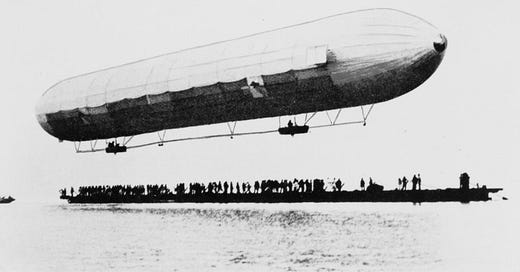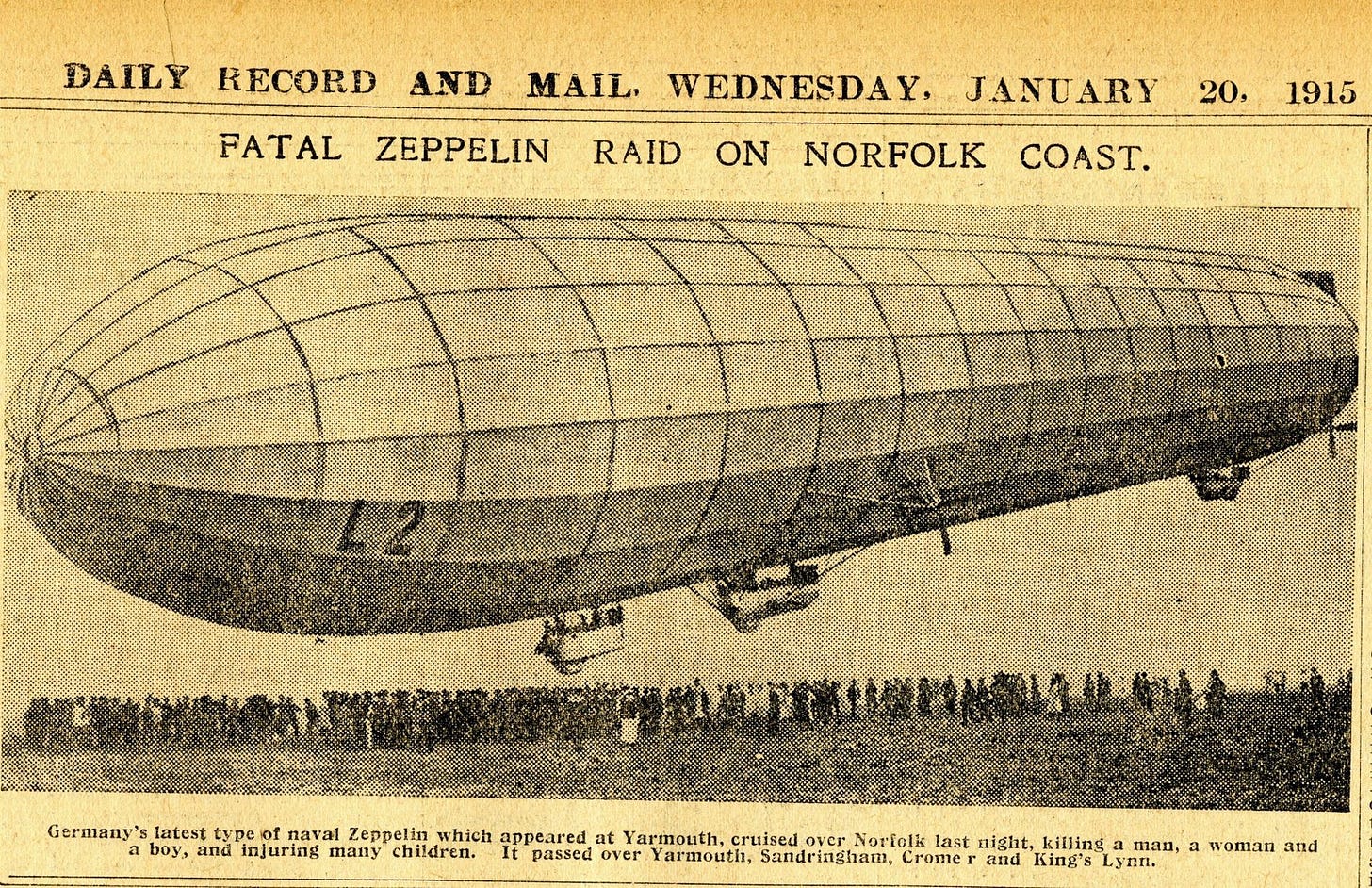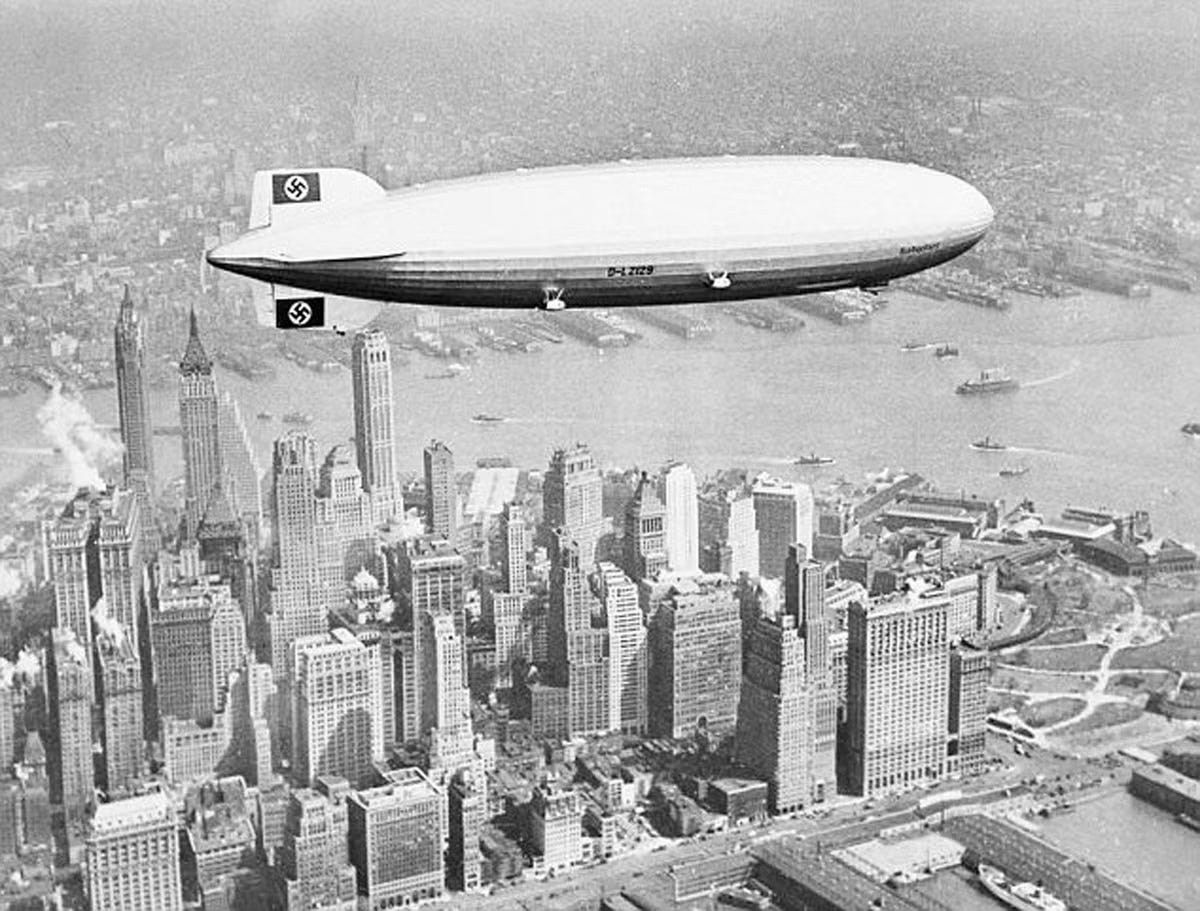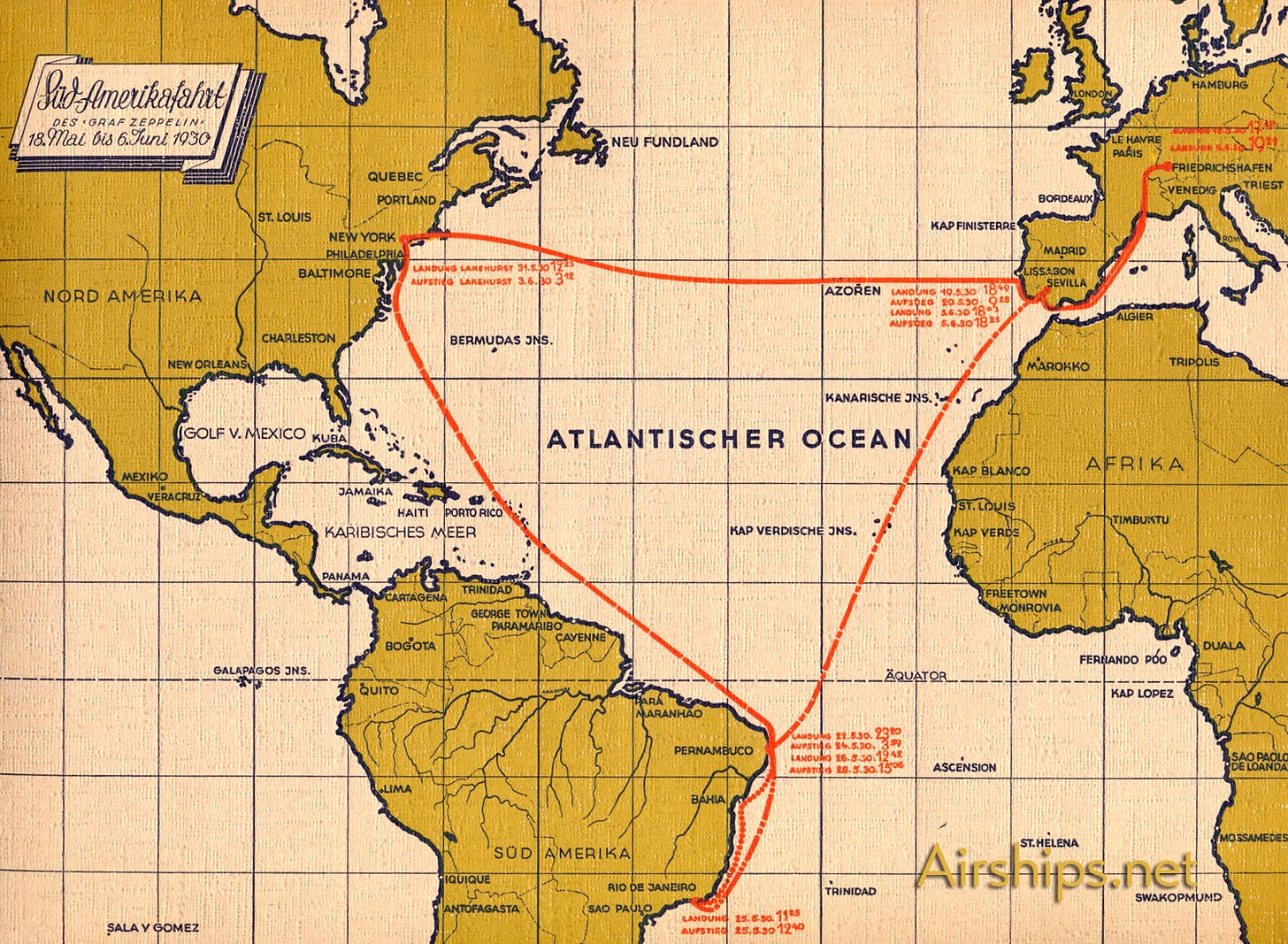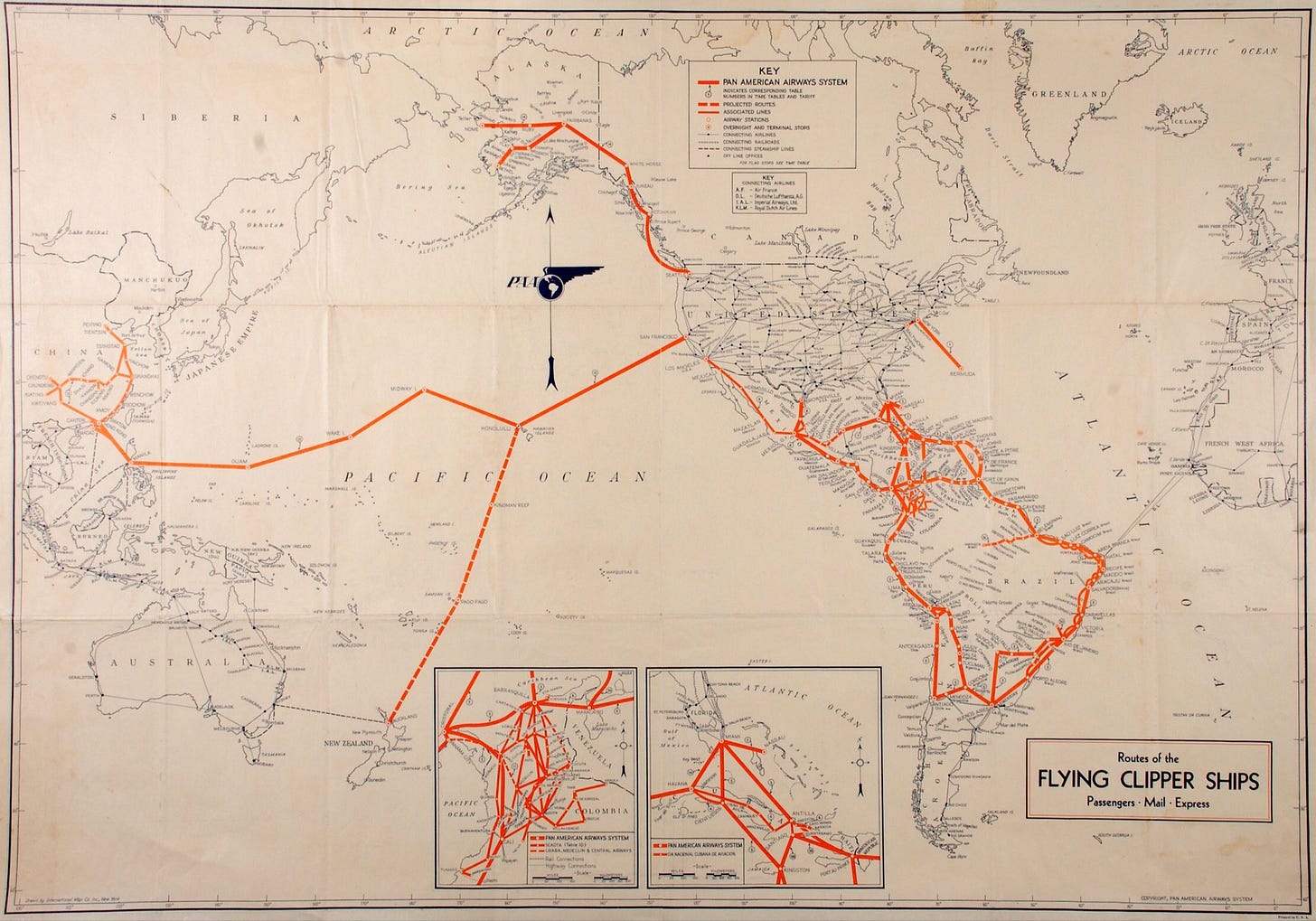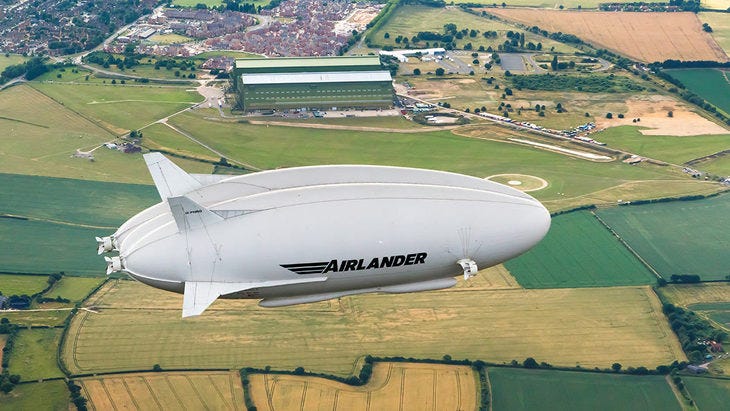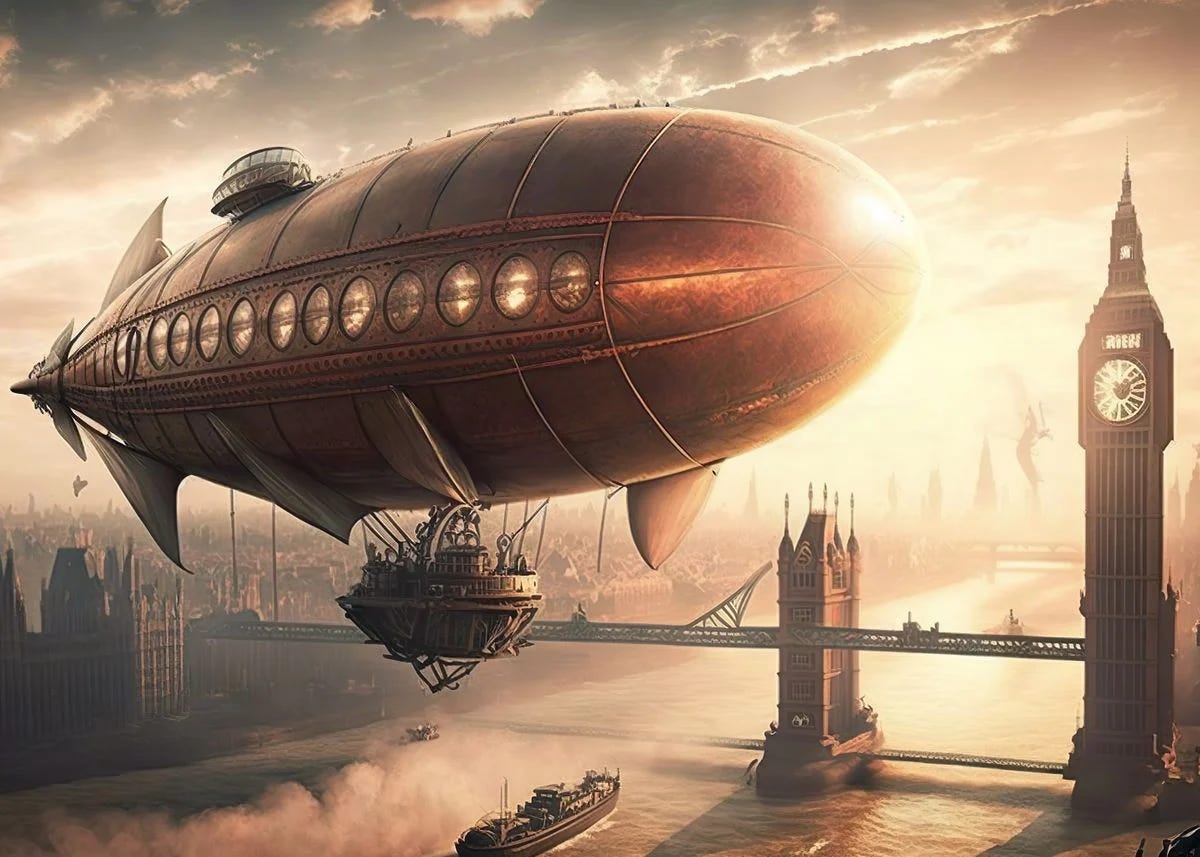What was a “Zeppelin”?
When most Americans think of “Zeppelins,” they recall the disaster in New Jersey when the Hindenburg caught fire and burned, its demise reported live. In reality, zeppelins had a longer life in both war and peace than Americans remember.
A zeppelin is a lighter-than-air transportation system that uses hydrogen or helium for the lift. It is built around a metal airframe, with multiple reinforced “gas bags” that were separated to ensure that if 1 or 2 gas bags collapsed, the airship would remain aloft. Both blimps and zeppelins are dirigible airships, which are lighter-than-air crafts that are both powered and steerable. This is opposed to a balloon, which is free-floating.
Zeppelin was named after the German inventor Ferdinand von Zeppelin, who pioneered rigid airship development at the beginning of the 20th century. The first zeppelin was launched in July of 1900, about 3 ½ years before the Wright Brothers flight - which was created as heavier than air flying machine.
Early Use, Problems, and World War I
Zeppelins were created for transportation in Germany. The first zeppelins were used for transportation, flying between cities in Germany, and pleasure flights started in 1910. These flights were usually short sightseeing jaunts. The project would undergo several iterations and many mishaps before scheduled service could begin in earnest in 1912.
By the outbreak of World War I, the zeppelin route system had flown 1588 flights and carried 10,197 fare-paying passengers in Germany. At the beginning of the war, the German navy and army conscripted the airships for use in the battles. There were a few notable Zeppelin attacks, including multiple raids against England during the war. They were terror-inducing, but the difficulty in piloting the airships in rough weather made them less effective than planned. As defenses in England improved, some zeppelins were repurposed for raids in the Balkans and the eastern front in Russia.
The primary use of the airships was patrolling for the Navy. The Navy flew over 1,000 patrols in the North Sea and the English Channel.
We should note the limited use of airplanes in World War I. Today, we wonder why the use of zeppelins was favored over airplanes. Despite the fame of the Red Barron and his dogfights, most airplane flights during World War I were used not to attack or drop bombs but to scout out enemy positions. Zeppelins could stay up longer, fly farther, and provide more information than airplane surveillance. Their use in battles was limited by the ease of hitting them with anti-aircraft guns. Their slow speed and large turning radius made them easy targets.
A total of 84 Zeppelins were built during the war. Over 60 were lost, roughly evenly divided between accident and enemy action. 51 raids had been made on England alone, in which 5,806 bombs were dropped, killing 557 people and injuring 1,358. It has been argued the raids were effective far beyond material damage in diverting and hampering wartime production: one estimate is that due to the 1915–16 raids, "one-sixth of the total normal output of munitions was entirely lost.” (Wikipedia data)
When the war ended, there were two huge zeppelins still flying. Both were given to allies (the US and France) as war reparations, and no more were allowed to be built by treaty. The zeppelin delivered to the United States was rechristened the USS Los Angeles. The Americans changed out the Hydrogen for Helium, and the airship was in service until 1932.
Hydrogen vs. Helium
There was never an argument about what lighter-than-air gas should be used. Helium was inert and safe for use. Hydrogen was flammable and dangerous. The German zeppelins used Hydrogen because the United States had a monopoly on Helium and did not export it. American military feared possible enemies would use exported Helium.
Interwar Period
Under the Treaty of Versailles, the German Air Force was disbanded, and all planes and airships had to be surrendered. The Treaty was relaxed in 1924 and 1926 as Germany was contracted to build zeppelins for the United States and others.
In 1929, the largest airship to date, the Graf Zeppelin, was built and toured the world. It was the first zeppelin to circumnavigate the world, with financial support from people, including William Randolph Hearst. It also navigated the Arctic once in a quest to define its versatility. The success of the airship led to scheduled service between Germany and New York, as well as Germany and Brazil (Rio de Janeiro).
At the same time, plans were being drawn up in England to use these giant airships to travel the British Empire. British and Americans explored the production and use of airships, but the difficulties of building and controlling them limited their adoption.
In 1933, the NAZI party took control in Germany and found the zeppelins an impressive propaganda tool. The swastika could be carried on the tail, and Germany would keep other countries in awe. The Hindenburg flew regularly scheduled transatlantic flights for over a year before the famous Lakehurst, New Jersey fire. In 1937, the Hindenburg exploded, and zeppelin travel ended. The remaining zeppelin was retired from flying and was turned into a museum.
The Pan Am Clippers as Competition
Indiana Jones movies reintroduced the Pan Am Clipper to Americans. Its long routes across the Pacific are the stuff of legends. The Pan AM Clippers and the Luftschiffbau Zeppelins are remembered today as the heights of sophistication.
The Clippers and the Zeppelins did not compete for the same routes and never really competed against each other. The Clippers were faster but limited by distance. The much more massive zeppelins were not limited by distance but were more expensive than ocean liners. Zeppelin service was a deluxe travel experience related to the great Atlantic Passenger ships.
The Zeppelin and the Clippers never competed on the same routes, but they did compete in people’s minds. The Zeppelins were majestic, offered fantastic views, were faster than a ship crossing, and flew routes to Brazil at the peak speed. The Clippers offered a level of style and faster service. They were more profitable along many more routes.
The outbreak of World War II in Europe, coupled with the Hindenburg disaster (in 1938), heralded the end of the zeppelin as civil transportation. After the retirement of the Zeppelin routes between Europe and North America, Pan AM began Clipper service to Europe. It was famous as the route of the most luxurious Pan Am Clipper, the 314. But when the war spread to the United States (at the end of 1941), the 3 years of deluxe Pan AM Atlantic Clipper service ended. The war effort meant larger, faster planes designed for practicality, not deluxe travel. After the war, transportation speed was more important than luxury. Luxury seemed a vice after the war, and the great Zeppelins and Clippers did not recover.
The Future
Zeppelins are wrapped in nostalgia, so predicting a future from them is often more wish fulfillment than reality. The original home of the zeppelin is once again building them. This time, the airships are smaller and used for sightseeing trips in Germany.
There was a period between 10 to 20 years ago when the idea of airships (blimps, zeppelins, etc.) had potential. There were plans for airships built in a style of a single large wing to help with speed or gigantic airships to deliver goods to places that are otherwise unreachable, places like the Amazon Forest, Arctic, or interior of Africa. These are interesting ideas but do not make economic sense. Faster delivery can be made by plane or drone. Cheaper delivery can be made by land or seacraft. Where these are not possible, the cost of delivering goods is probably more than the recipient can pay to fly a zeppelin. The cost of delay from wind or storms exacerbates these costs.
When electric planes were considered impossible, there was interest in zeppelins, which might be able to line their outer skins with solar panels. But as electric planes are proving viable, even this tactic will fail.
Rigid lighter-than-air ships will probably be limited to sightseeing, advertising, and sports stadium flyovers. And the delightfully weird and wonderful world of fiction’s “steampunk”.

